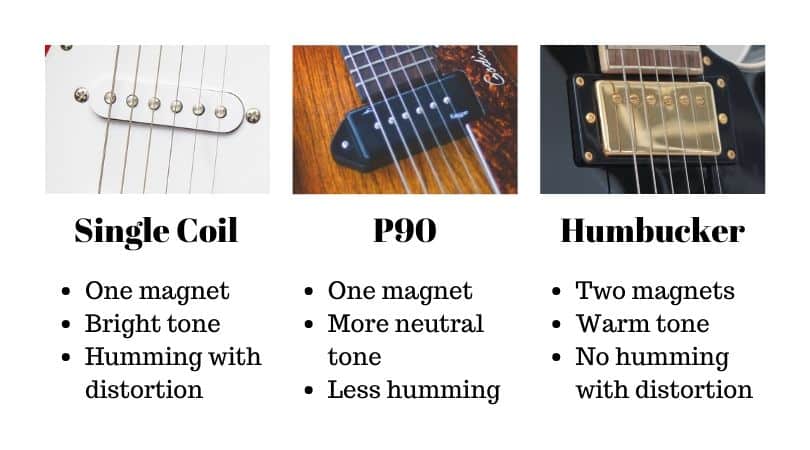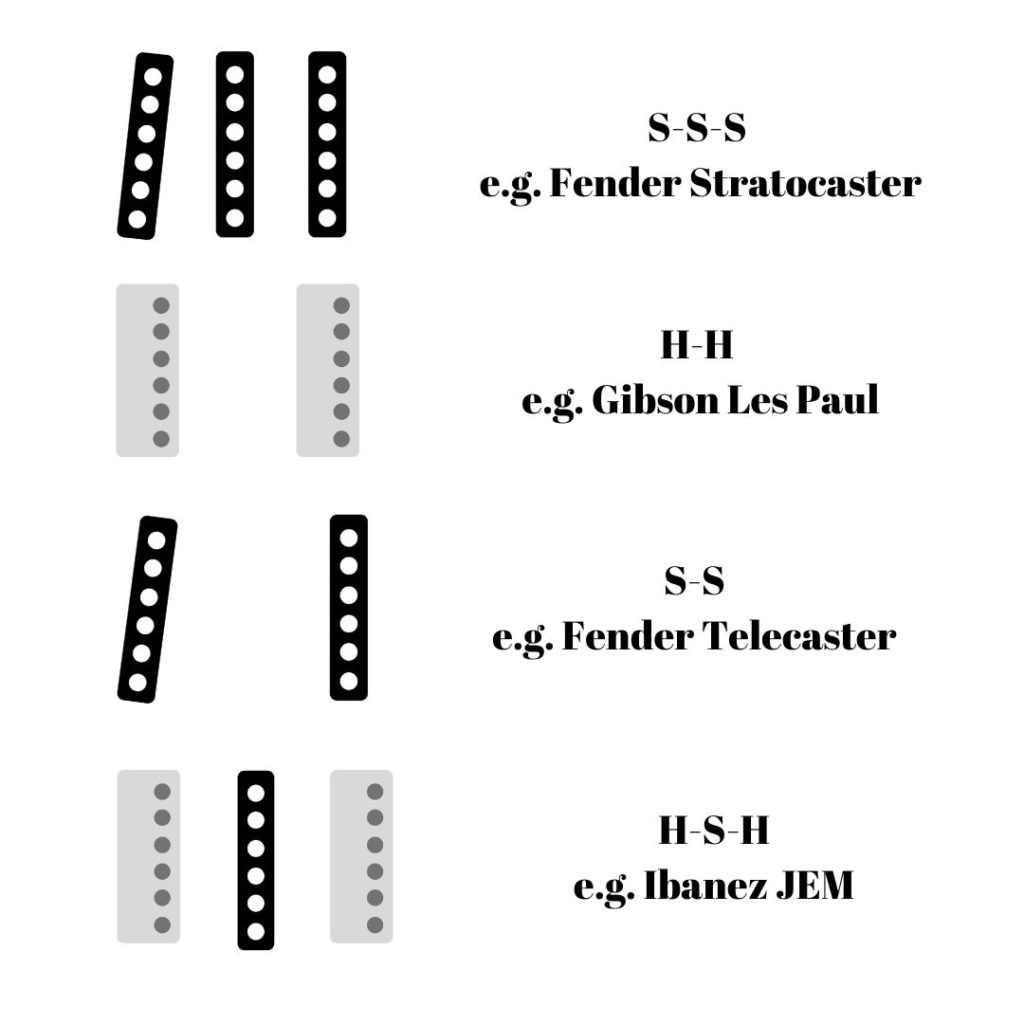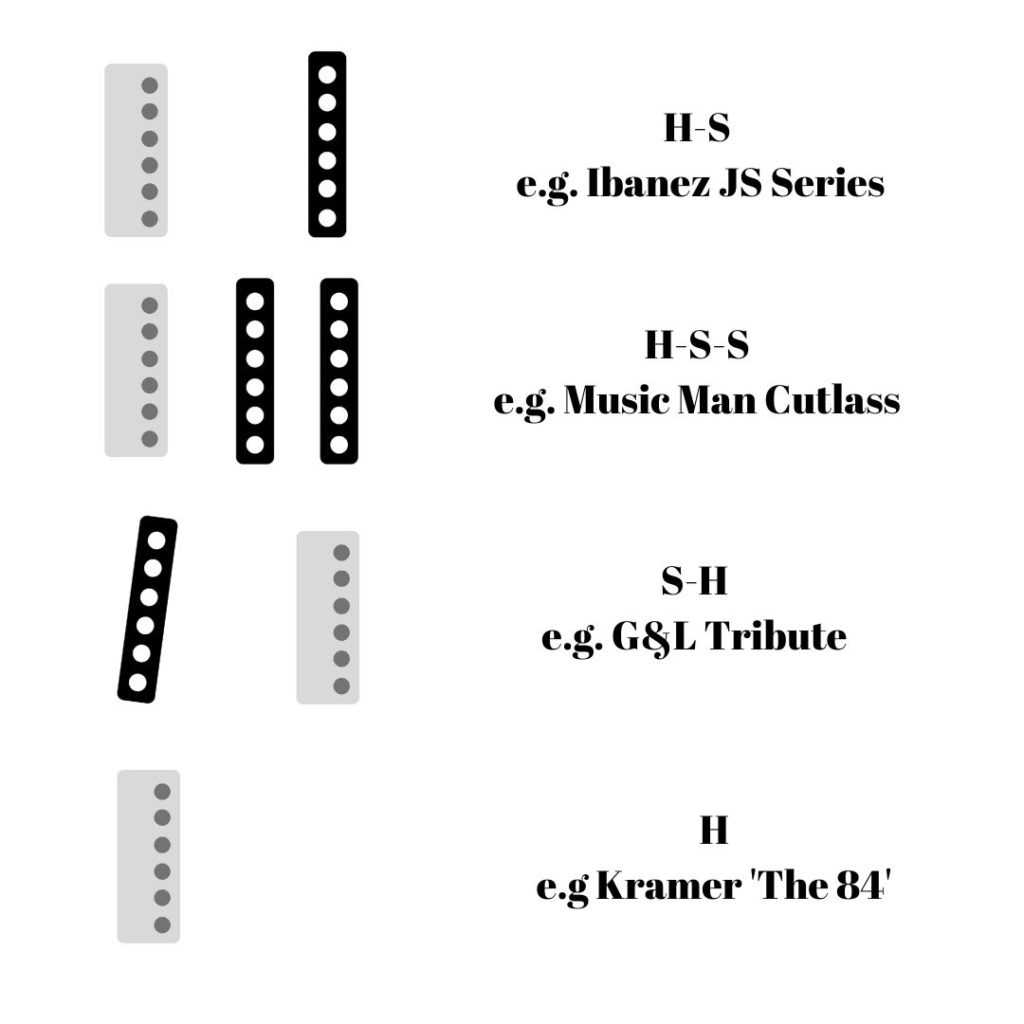There are tonnes of different brands and models of electric guitar pickups, and three main categories: single coil, P90 and humbucker.
They all have the same function, to detect the sound of the strings and send it to the amplifier so you can hear the guitar through the speakers. But, their different structures allow them to achieve different sounds.
I’ve created this guide so you know all about each type of pickup, and the differences between them so you can decide which is best for you. So let’s get started!
The Quick Answer
Single coil pickups produce a brighter sound compared to P90 pickups. However, single coils typically suffer from more feedback so are not usually selected for heavy rock and metal. Both single coils and P90 pickups use one row of magnets.
Humbucker pickups produce a warmer and louder sound compared to single coil and P90 pickups. The double magnet design allows them to reduce the level of feedback produced, making them more suitable for heavy rock and metal compared to the one magnet design of single coils and P90’s.
Pickup 101
Put simply, a guitar pickup is a magnet, which senses the vibrations of the strings and then converts them into an electrical signal which is sent to the amplifier and then played through the speaker.
- Pickups are made of a core material.
- The main core materials are ferrite (ceramic material made by mixing iron oxide with other metal elements) and alnico (a family of iron alloys consisting of aluminium, nickel and cobalt).
- These cores are then wrapped in coils of copper wire.
- The number of coils and the material of the core are two properties which can be changed to alter the sound of the pickup.
- The magnets (core wrapped in the coils of wire) are then held in place by the bobbin which is usually made of molded plastic.
Looking to learn more about pickups and how they work? Check out my complete guide to electric guitar pickups to learn everything you need to know.
Brief Pickup Comparison
Now you’re all clued up on the structure and function of a guitar pickup, let’s move on to a quick comparison between the three main types: single coils, P90s and humbuckers. After that, I’ll go through each individual pickup type in more detail.
- Single coil pickups use one magnet. They generally produce the brightest sound and are used on Strats and Teles. The main disadvantage is that you’ll get a humming sound with high distortion.
- P90 pickups also use one magnet like single coils, but they have a wider bobbin. This means that they have a higher output than single coils so more depth of sound, and less humming.
- Humbucker pickups use two magnets, so they are kind of like having two-single coil pickups working together. They have a warmer tone and higher volume and are famously found on Gibson Les Pauls.

Single Coil Pickups
what is the structure?
Single coil pickups consist of one magnet, so this is just one core material wrapped around with copper.
what do they sound like?
They are best known for their bright tones. They sound crisp and twangy as they favour high-frequencies (treble), and has less emphasis on low-frequencies (bass). They have a fairly low output compared to the other pickup types meaning they sound quieter.
The main issue with single coil pickups is that they don’t cope with high gain very well. If you crank up the distortion too high, then you’ll hear a “humming” sound.
What styles of music do They Suit?
Due to their bright and twangy sounds, single coil pickups are commonly used for blues and country music because they are great for clean tones.
The humming issue when using high gain means they are less commonly used for metal and heavy rock, however this is not a rule. Some guitarists still use single coil pickups through a distorted amp so they are used for rock as well.
which guitars use them?
Advantages
- Great for clean tones
- Crisp and bright sound
Disadvantages
- Quieter than other pickups
- Humming with high gain
P90 Pickups
what is the structure?
P90 pickups also use a single magnet, like single-coil pickups. The main difference is that they have a wider, but shorter bobbin (the casing around the pickup).
what do they sound like?
Due to this wider bobbin, P90 pickups have a higher output than standard single coil pickups, but not as high as humbuckers. This is why the sound of P90s is commonly referred to as a cross between single coils and humbuckers.
The tone has more depth and volume than single coils and are less twangy, but not as warm and loud as with humbuckers. P90s tend to suffer less with humming than single coils do, although they still don’t cope as well with high gain as humbuckers.
what styles of music do they suit?
which guitars use them?
Advantages
- Balanced sound
- Less humming than single coil
Disadvantages
- Still has a humming issue
- Rarer than other pickup types
There are actually two main types of P90 pickups with some subtle differences between them. Check out my comparison between dog ear and soap bar P90 pickups to learn more.
Humbucker Pickups
What is the structure?
what do they sound like?
The dual magnet design has the main function of reducing the humming found at high gain, hence the name “hum-bucker”. They have a warmer and more mellow tone than single magnet pickups and are also louder as they have a higher output.
what styles of music do they suit?
Humbuckers are great for high gain styles of music like heavy rock and metal. They can still be used for cleaner tones, however, they are less commonly used for country music than single coil pickups. Humbuckers and in particular, ones with a coil splitting or tapping function, are very versatile. Check out this post on coil tapping if you want to learn more about this feature.
which guitars use them?
They are most famously used on Gibson guitars like the Les Paul and SG. Many manufacturers also use them too though, like Ibanez, PRS, Jackson and ESP.
Advantages
- No humming with high gain
- Higher volume
Disadvantages
- Sometimes too mellow for clean tones

Active vs. Passive Pickups
As well as the different structures of the pickups, there are also two additional types: active and passive. Both types have the same function, to detect the sound produced by the string vibrations. However, they sound different.
Passive Pickups
This is the most common type and they are used on most guitars. Passive pickups don’t require a battery.
Active Pickups
Active pickups on the other hand, use a battery which boosts the signal. The use of this battery means that there are less coil winds than with passive pickups.
Key Differences
Passive pickups have more coil winds, to increase the output because they don’t have a battery. However, if there are too many winds, then the treble becomes too weak. This means, the sound is less crisp and clear. This is a problem with high gain, as the sound can become muffled.
Active pickups on the other hand have fewer coil winds and instead use a battery to boost the output. The battery causes the sound to be powerful despite the fewer number of coils. The result, is a crisper sound at higher gain, hence it’s why active pickups are commonly found in heavy metal music.
Check out this comparison between active and passive pickups to learn all the pros and cons of each type of pickup
Pickup Configurations
To complicate things even further, you also can use different pickup configurations to change the kind of tone you achieve.
All electric guitars have at least one pickup, but the majority will have two or more. If your guitar has more than one pickup, then you’ll have a pickup selector which allows you to change which one is activated.
Here’s how the position affects the sound.
- Neck pickup: sounds softer and more mellow as it emphasises low-frequency or bass sound (generally used for rhythm guitar).
- Bridge pickup: sounds brighter and crisper as it emphasises high-frequency or treble sound (generally used for lead guitar).
Different Combinations


Guitar Center are always the first place I look at when I’m interested in a new electric guitar because have a huge range of models for sale and always have some excellent deals on. Here’s a link to take you directly to Guitar Center’s electric guitar range so you can see all the offers available at the moment.
In Summary
Hopefully you know plenty more about the different pickup types, their sounds and the different configurations. Here are a few points to take away.
- There are three main pickup types: single-coil, P90 and humbucker.
- Single coil pickups sound brightest, but have a humming sound at high gain.
- Humbuckers sound more mellow and do not suffer from any humming.
- P90 pickups are a variant of single coils, but sound a bit more mellow and have less humming, but not as little as humbuckers.
- Pickups can also be divided into two categories: active and passive. Passive are most common and tradition, active are great for metal because they offer more clarity when higher gain is used.
- Different pickup types can be used on the same guitar to offer different tone options.
I’ve written a complete buyer’s guide for electric guitars which takes you through all the things you need to consider and a step-by-step method to narrowing down your selection and choosing the best option. Here is a link to the article.
So there you go! That’s a guide to the differences between single coil, humbucker and P90 pickups! I hope you’ve found this article helpful, thanks for reading. Here are some other posts you might find useful:
